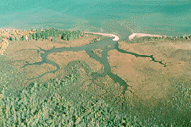
estuarine coastal ecosystem

We all know that rivers start in the mountains and flow down towards
the sea, right? Where the flowing river meets the sea, you'll find an
estuary.


Estuaries are unique
ecosystems because they have a combination of fresh water and salt
water (from the sea). The incoming salt water sits along the bottom,
and the outgoing fresh water floats over the top, so the water is
very unusual.
Estuarine ecosystems are also fragile. Any disturbance - such as
pollution, temperature rise, extinction of any one type of living
thing - could have a serious effect on the ecosystem.
Going back to our checklist - let's see how an estuarine ecosystem is
made up.
1. Physical environment (surroundings)
There is a lot of salt and fresh water in the estuary. Under the
water is sand and soil. The estuary is shallow and when the tide goes
out, the land is flat.
2. Living things (plants and animals)
There are loads of living things in the water and in the rich soil
under the water. You'll find land, marine and freshwater animals,
including birds, fish, insects, reptiles and shellfish, and plants
(such as the fabulous mangrove).
3. How living things live in their surroundings
In every ecosystem, there is a food web (sometimes called food
chain). The food web is a list of 'who eats who' in the ecosystem.
For example, birds in the estuary might eat fish,who in turn eat
insects.